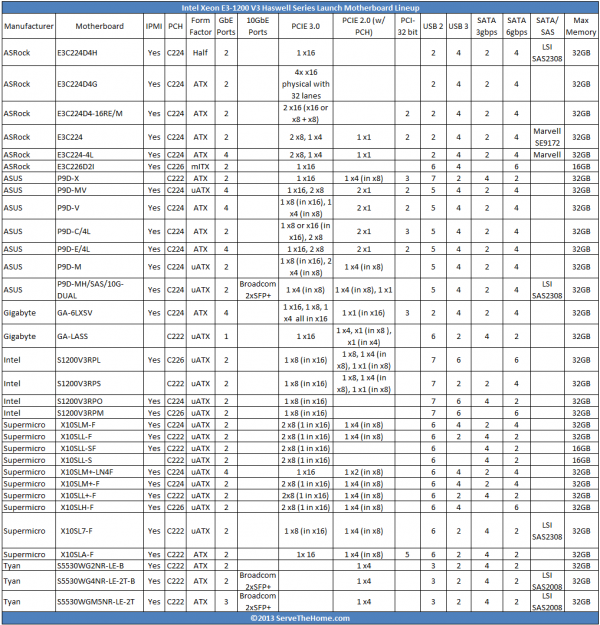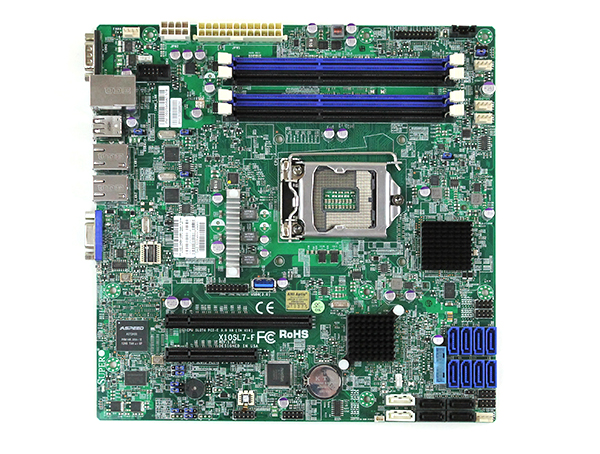Recently we posted several articles on the new server motherboards for the Intel Xeon E3-1200 V3 series. These motherboards are based on the new Intel Haswell architecture and utilize the LGA1150 socket. We took all of the server motherboards, extracted key stats and built a table with the offerings. For those looking to build or purchase an Intel Xeon E3-1200 V3 based server, this should be a good starting point. We have included ASRock, ASUS, Gigabyte, Intel, Supermicro and Tyan server motherboards in the comparison table.
Here is the table. One request, if you spot something that looks off, or a LGA1150 server motherboard that is not on here, please let us know. We will do our best to keep this as accurate as possible but from time to time typos happen. Please feel free to contact us here or on the forums if you spot an error.

As you can see, there are a few trends. First, the Intel C222 chipset is the most popular building block. Next, we can see quite a few of the LGA1150 motherboard options still retain the PCI slot. The addition of USB 3.0 on socket LGA1150 server motherboards is great for those applications where one boots VMware ESXi off of a USB 3.0 flash drive for example.
We see almost all of the newest generation server platform motherboards adopting IPMI 2.0. Most of these motherboards also have dedicated IPMI ports which is something Supermicro and Tyan have been advocating for some time.
Five motherboards support LSI SAS controllers. Three utilize the LSI SAS2308 chipset while two from Tyan utilize the LSI SAS2008 chipset. As we saw in our Supermicro X10SL7-F review, the motherboard with integrated SAS2308 costs less at $255 than a new LSI 9207-8i card (also based on the LSI SAS2308) at around $280. The premium there is under $100 over the non-SAS version of the motherboard so the value is certainly there.
Three motherboards support onboard 10GbE. Interestingly enough, Broadcom got design wins here with SFP+ based dual port controllers. Whereas Intel provides the leading 1GbE server network controllers, 10GbE in socket LGA1150 favors Broadcom.





I’ve been putting off upgrading my NAS even though I have all the parts for it (LSI SAS controller and 2x 6-drive hotswap Intel enclosures). I might end up giving up on the LSI SAS add-in card and my current sandy bridge solution and switch to a haswell E3 v3 setup. That new Supermicro board at $260 or so is a steal!
– Asrock ‘E3C224-4L’:
—-
* the table omits the ‘L’ from the name;
* omits the two PCI slots [” … 2 x PCIe 3.0 x16, 1 x PCIe 3.0 x4, 1 x PCIe 2.0 x1, 2 x PCI …” – see refs below];
* seems to mangle the ‘2 x SATA3 by Marvell 9172’ info;
* and (in the usual way of such tables – incl ark.intel) kinda gives an ad-mixture of the info “4 x USB 3.0 ports (2 rear + 2 via header ) // 7 x USB 2.0 ports (2 rear + 4 via header +1 Type A) “.
—-
Ref:
http://www.asrock.com/server/index.asp
http://www.asrock.com/server/overview.asp?Model=E3C224-4L
rgds,
SC
– Asus:
====
—
* P9D-V has: three PCI slots, two LAN; table says/said two and two respectively.
Table also gives PCIe info quite different from webpage: the latter says – and note the version numbers:
“Expansion Slots
Total Slot : 6
Slot Location 1 : PCI 32bit/33MHz
Slot Location 2 : PCI 32bit/33MHz
Slot Location 3 : PCI 32bit/33MHz
Slot Location 4 : PCI-E x8 (Gen2 X4 Link)
Slot Location 6 : PCI-E x16 (Gen3 X16 Link)
Slot Location 7 : MIO Slot for Audio card ”
Ref: http://www.asus.com/Commercial_Servers_Workstations/P9DV/#specifications
—
* As elsewhere in table, method of counting usb2/3 seems to vary – cf e.g. P9D-X and P9D-V – between including on-board headers or not in the totals.
—
* P9D-C/4L: has 4 LAN, 2 PCI; table says/said resp two and three.
PCIe v3.0 specs seem to differ between table and Asus spec-page (ref below).
Ref: http://www.asus.com/Commercial_Servers_Workstations/P9DC4L/#specifications
====
rgds,
SC
In the above comment, the text:
“P9D-V has: three PCI slots, two LAN; table says/said two and two respectively.”
should read:
” […] two and four respectively.”
Apols for the/any confusion.
rgds,
SC
Like the concept. Typos are ok.
Re. ‘P9D-C/4L’:
Hmmm. The manual (‘P9D-C Series’, ver E7916, downloaded via ‘http://www.asus.com/Commercial_Servers_Workstations/P9DC4L/#support_Download_5’) indicates two variant models, namely ‘P9D-C/4L’ and ‘P9D-C/2L’: they seem to differ only in that the former has 4 x lan, and the latter has 2 x lan; same ‘Intel I210AT’ for all lan ports.
Also, the manual, like the product pages on Asus website, are perhaps not entirely clear if ‘slot 7’ is a general-purpose pcie slot, or is just for ‘MIO’. I’ve seen similar ambiguity on other Asus boards, and more-or-less always was the case that ‘general-purpose’ was the answer.
Btw, am not carping or fault-finding in making these feedbacks.
Rgds,
SC
Interestingly, most of Mini ATX motherbords support only 32 gigs of RAM…